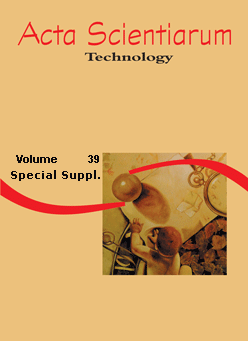<b>Inoculum concentration and inoculation time for propionic acid production from whey using mixed culture of <i>Lactobacillus helveticus</i> and <i>Propionibacterium freudenreichii</i> PS-1
DOI:
https://doi.org/10.4025/actascitechnol.v39i5.29479Palavras-chave:
skimmed whey, lactic bacteria, propionic fermentation, organic acids.Resumo
Â
The production of propionic acid using skim serum by-products of the dairy industry was investigated, and the influence of inoculum concentration of Propionibacterium freudenreichii PS-1 and its time of inoculation for the production of propionic acid was evaluated using mixed culture of Lactobacillus helveticus and Propionibacterium freudenreichii. Initially, the adjustment of propionic bacteria to higher concentrations of propionic acid was tested and kinetic parameters were determined for growth. A central composite rotational design (CCRD) with 11 experiments was carried out, using different inoculum concentrations of P. freudenreichii, which were added to the cultures of lactic bacteria at different times. The maximum specific growth rate for P. freudenreichii decreased from 0.11 to 0.03 hour-1and the growth time increased from 32h to 100h when concentration of propionic acid in lactate broth increased to 0.25%. The best result for propionic acid production was 3.78 g L-1, inoculating 5.108 CFU mL-1 of propionic bacteria after 6 h. For lactose consumption, the best conditions were inoculum concentration above 5.108 Â CFU mL-1 and inoculation time of P. freudenreichii after 6 hours. Therefore, it was demonstrated that skimmed whey can be used as a renewable, low-cost raw material for propionic acid production by mixed culture.
Â
Downloads
Downloads
Arquivos adicionais
Publicado
Como Citar
Edição
Seção
Licença
DECLARAÇíO DE ORIGINALIDADE E DIREITOS AUTORAIS
Declaro que o presente artigo é original, não tendo sido submetido í publicação em qualquer outro periódico nacional ou internacional, quer seja em parte ou em sua totalidade.
Os direitos autorais pertencem exclusivamente aos autores. Os direitos de licenciamento utilizados pelo periódico é a licença Creative Commons Attribution 4.0 (CC BY 4.0): são permitidos o compartilhamento (cópia e distribuição do material em qualqer meio ou formato) e adaptação (remix, transformação e criação de material a partir do conteúdo assim licenciado para quaisquer fins, inclusive comerciais.
Recomenda-se a leitura desse link para maiores informações sobre o tema: fornecimento de créditos e referências de forma correta, entre outros detalhes cruciais para uso adequado do material licenciado.



















